MARKET OVERVIEW
The global milk market will increasingly cater to the diverse demand needs by consumers. Now innovation and differentiation on the part of producers will be spurred by different needs for organic, lactose-free, and fortified milk products. With a growing health-conscious consumer base, the industry will be more likely producing milk that has such needs. The other significant factor that will determine the future of the industry is sustainability. Environmental concerns linked to dairy farming will force producers to look for greener techniques that will change the way milk will be produced and distributed globally.
The global milk market for a long time to come because of the very complex interactions of those two attributes. It refers to multiple forms of milk such as fresh milk, dried, powdered, and condensed milk, all catering to the needs of consumers globally, unlike other requirements. Someone will always be consuming milk added to his food, so in terms of importance to nutrition and diets, its significance will be enduring, perhaps going on to influence the operations of producers and suppliers in this industry as well. Well, this industry was sculptured by traditional markets like Europe and North America, but now efficiency and effectiveness in milk consumption in Asia Pacific and Africa will reconstruct the strategies of such countries in meeting new consumer behaviors and tastes.
Processing and packaging innovations are going to be the major roles that technology will play in the global milk market because technology would help increase the quality and shelf life of milk products. In the future, a lot of applications will make use of ultra-high temperature processing, where milk can be held for gentle storage for an extended amount of time without refrigeration. This will be particularly relevant in regions that have not fully developed cold chain. Smart packaging solutions will provide consumers with all the details they require about the product, such as its history and nutritional content, thus aligning it with the transparency principles of modern consumers.
Trade and regulation will also shape the future of this global milk market. How these between countries will flow milk and dairy products will be driven by different international trade agreements, changes in price, and availability. Tariffs, subsidies, and import restrictions, however, will still be one of the most important elements in how milk is transported worldwide. Change in trade pattern will be one thing countries see in the market trying to protect their local dairy industries, thus changing a global milk price as well as competition among producers.
Local culture will always remain a major component of the global milk market. For most parts of the world, milk became more than a commodity but transcended culture; therefore, producers must also take into consideration the customs and traditions of the people in marketing their products.
Global milk market is estimated to reach $978.2 Million by 2032; growing at a CAGR of 4.3% from 2025 to 2032.
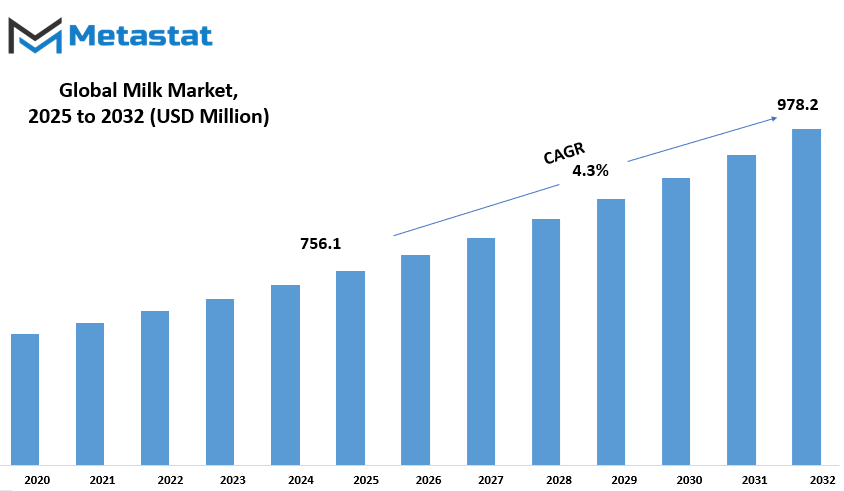
GROWTH FACTORS
The global milk market may likely face some challenges that could hinder its growth. Of course, lactose intolerance and dairy allergies, being health conditions of high prevalence, nonetheless affect a significant number of the population who are thus restrained from consuming milk and its products. Definitely, companies would require a lot of innovation here; perhaps some will come up with lactose-free or alternative dairy commodities that would still retain some attributes of milk while going after customers with such dietary restrictions.
One part of the rising milk demand in the world is attributed to increasing consumer awareness, while the other is demand from developing economies, thus augmenting the global growth forecast for the milk market in the coming years. Due to increased consumer awareness regarding the benefits of drinking milk, in the near future, the demand for milk is expected to rise globally. Milk is one of the major sources of these nutrients; it is abundant in calcium, proteins, and vitamins and constitutes a part of various food habits. Thus, this awareness shall be one of the major propellers of increased sales of milk across the globe.
The demand for dairy products is, on the other hand, increasing in developing economies. Besides urbanization, with increased disposable income, people could afford to add more dairy to their diet. Increased demand compels producers to produce more milk that satisfies consumer needs, thus, enhancing market growth. Higher demand for fortified milk and flavored milk and other value-added dairy products creates a new stream of income for producers. The consumer purchasing such products is looking for more than basic nutrition, while taste and health benefits become the strong selling points. Hence, these will provide new chances and growth paths for the market.
The other possible outgrowth that would influence market growth is the increase in milk prices. Such distresses in the supply chain and variable prices in feed, among the many economic determinants, have rendered prices highly erratic. This has ceased forecasting production by the producers and consumption by the consumers. It may lead to no market stabilization at all affecting the reproductive levels with that of the producer and their purchasing power at the hands of the consumer. Therefore, firms will have to think of ways to stabilize their prices by improving their supply chains or using production methods that are shock-resistant.
Challenges and opportunities would provide a roadway following which continuous change shall evolve in the global milk market. Growth drivers like increased awareness of the nutritional values of milk and rising demand from emerging economies are likely to be the pull factors propelling the market. The industry needs to combat lactose intolerance, dairy allergies, and price fluctuations to keep the growth rolling.
MARKET SEGMENTATION
By Source
Consumer preferences are being increasingly driven by the innovations emerging throughout the dairy sector into the foreseeable future. Demand for milk may vary greatly for usages dictated by consumers. There will be much variety in special milk products for consumer needs and health trends based on the source. Each type of milk has its unique advantages, so awareness of these benefits would automatically grow demand for each segment.
However, cow milk will continue to hold acknowledgment for its easiness of availability and nutritiousness and thus will remain the dominant species in the global milk market. But due to increased health consciousness among consumers and the resulting search of alternatives-goat milk-that could offer better digestibility and other nutritional constituents-is up and coming for realization. Buffalo milk will remain a segment of niche consumers desiring stronger flavor and creaminess.
Less conventional, on the other hand, sheep milk will cater to a niche market with a propensity for its unique flavor profile and heightened levels of certain vitamins and minerals. Good comparisons would be camel milk: relatively newer with super-positive reviews concerning health, it has gained acceptance in the marketplace appealing to those requiring substitutes to more traditional products.
Moreover, the trend for plant-based milk is going to have a major effect on the global milk market in the future. The soaring number of consumers shifting to a vegan or lactose-free diet will result in an ever-increasing demand for almond, soy, oat, and rice-based plant milk. A continuous innovation drive on taste, texture, and nutritional topics will further assure appeal of this sector to a major consumer base.
The global milk market, as a whole, will basically be a battlefield between traditional and alternative kinds of milk. An increasing interest by consumers in health, sustainability, and diet will ensure a continued interest in a galaxy of milk products. There shall be room for every kind of milk as the market reshapes itself to meet the alternative current and future consumer demands in this dynamic and competitive atmosphere. That will be the answer as to why the global milk markets shall indeed be very reactive to fluctuating consumer needs and trends and to whatever is preferred in the years to come.
By Form
The future course of the global milk market shall evolve in parallel with the changing preferences among consumers and advances in technology within dairy processing. As the demand for milk products grows across the continents, the market would take several forms to comply with variant consumer demands with respect to health concerns. Key forms in this market are Whole Milk, Reduced-Fat Milk, Low-Fat Milk, and Skim Milk. This way, each of the segments can appropriately target certain demographics while also placing the offering much about remaining a staple in every corner of the globe when it comes to diet.
Since whole milk has a very full flavor and a higher fat content, it is probably going to tend to maintain its traditional patrons who appreciate flavor and mouth feel. However, the inclination would be toward less fatty alternatives with more emphasis on health issues in terms of demand. This will serve as a compromise for those who enjoy full, flavorful milk without all that fat about the level of very high fat--in Reduced-Fat Milk. Demand from this sector would increase as people get more health-conscious about their dietary fat intake.
Low-fat milk had already been a sweet spot for health lovers, but will now bulge much more in coming years. According to experts, the global population gain will be growing aware of the harm posed by excessive intake of a high-fat diet. The healthier variant among these will be called low-fat milk, which will provide all the goodness of milk with not a hint out of taste compromise. This milk type would be accepted by every kind of person, from fitness fanatics to those suffering from chronic conditions such as heart ailments or even obesity.
In future, skim milk with the least fat will also become an important contributor to the global milk market. People with zeal would be adopting skim milk as low-calorie foods and beverages go. These people will probably want to cut down on their caloric intake while not losing their intake of milk benefits. It appeals perfectly to an increasingly vegan and vegetarian populace who enjoy their plant-based alternatives but still consume milk.
That by the year's end, the global milk market will be one characterized by diversified milk forms meeting particular consumer needs and preferences. Continuous market growth, as such, indicates that the innovation part in the dairy domain processing and better understanding of consumer health issues could spur innovations through new product development. The segmentation by milk form Whole Milk, Reduced-Fat Milk, Low-Fat Milk, and Skim Milk will keep the market on its toes to move in line with the global health trends that position milk as an essential element in diets worldwide. The global milk market shall change and evolve with the changes in this evolution of needs, providing avenues to the changing consumer while keeping a focus on health, nutrition, and taste.
By Distribution Channel
It is expected that in the coming years, many changes will unfold in the global milk market, driven by shifting consumer behavior, the development of newer technologies, and transforming distribution channels. While demand for milk and milk products will continue to trend upward in the global market, further out, the distribution channels will continue to develop and cater to the differentiation of consumer needs.
Supermarkets and hypermarkets will remain the largest channel with the most significant value share of the milk industry. Fresh, organic dairy products, lactose-free, and plant alternatives are among the many items offered in these large retail outlets. These would remain one-stop convenience places, hence keeping hypermarkets and supermarkets a huge slice of the pies. These channels are increasingly expected to differentiate their portfolios in the future with greater input of locally sourced and eco-friendly milk, thus responding to consumer demand for ethical and environmental friendly products.
Convenience stores aided by easy accessibility and fast service will become integral to the global milk market. These allow single-serve dairy items to be conveniently purchased by consumers; hence, these stores are going to be the source for it. As consumers are fast-paced in this ever-improving urban world, they would keep on relying on convenience stores to quickly grab necessities like milk for consumption. Single-serve ready-to-drink milk products are predicted to line the chiller shelves for 'on-the-go.' Given that they will be gradually upgraded, these outlets will develop advanced inventory management systems, ensuring the availability of immediate consumer requirements with fresh milk products.
Online retailing is projected to be an emerging sector in the global milk market. Besides the convenience of home delivery, consumers are attracted to buying milk through e-commerce from the viewpoint of ease in comparing prices and going through product reviews. Online retails are likely to grab the major share in the coming times. Owing to a developed digital infrastructure, this alternative mode of distribution is generally expected to be highly engaged in populated areas. Also, subscription service for milk delivery would only promote the growth of this channel even more by providing the consumer with a regular supply of good-quality fresh milk and throwing the burden of placing repeated orders on the service itself.
Specialty stores will survive as long as they continue to satisfy the consumer's need for high-quality or specific milk products. Specialty stores which deal in premium and niche products thus cannot fail with a unique range of milk products: organic, grass-fed, artisanal.
By Application
The global milk market is bound to experience several more transformations in application sectors over the next few years although it will continue to serve a long list of broad applications. From the application standpoint, the areas of classification include Household Consumption, Food and Beverage Industry, Dietary Supplements, Cosmetics and Personal Care, Animal Feed, and Others, amongst which every segment will develop differently to cater to the fresh needs of consumers and industries alike.
Household consumption is one of the most important characteristics of the global milk market. Consumer preference is shifting towards better quality and healthier products. The trends concerning organic milk and milk alternatives are here to stay, enforced by greater health awareness and animal welfare considerations. Companies will continue to innovate in these directions and provide fortified and enriched milk products to attract the health-conscious consumer, guaranteeing that household consumption will remain a strong emphasis in the global milk market.
Heading towards the future, the Food & Beverage Industry is another sector that will act as a great growth driver for the global milk market. With the rising demand for convenience food and ready-to-drink beverages, the related usage of milk as an ingredient could see a rise. These companies may even be inclined to provide other innovative applications of milk in their products to justify taste and nutrition. With advancements in technology and processing methods, this sub-sector will rise to the demand for milk-based products, matching the market dynamics towards consumers' changing preferences.
Milk has been and continues to be a rich source of essential nutrients in this market segment. The trend toward health awareness and good nutrition is going to keep the demand for milk-based dietary supplements at an increasing tempo. These will be tailored into products addressing specific nutritional needs, such as protein-rich supplements targeting athletes and calcium-enriched milk targeting the elderly. There will be an increasing amount of products that target specific health concerns in the global milk market and thereby further entrench milk as a key element in a healthy diet.
The Cosmetics and Personal Care efficiently contribute to strengthening the global milk market. Milk has historically been acknowledged for its fabulous skin-nourishing properties, and this section is likely to witness the emergence of newer products based on milk. Such products would be fashioned for the consumers willing to break away from the existing chemicalized treatment and towards natural, yet effective treatment for skin care. Milk-based cosmetics are poised to be more in demand since consumers are becoming more aware of the benefits that come with the usage of natural ingredients.
The global milk market is destined to see strong transformations, driven mainly by consumer behavior and industry novelties. Milk-based products, originally known and enhanced, will still manage to enter more and more into the markets in all segments.'
|
Forecast Period |
2025-2032 |
|
Market Size in 2025 |
$756.1 million |
|
Market Size by 2032 |
$978.2 Million |
|
Growth Rate from 2025 to 2032 |
4.3% |
|
Base Year |
2025 |
|
Regions Covered |
North America, Europe, Asia-Pacific, South America, Middle East & Africa |
REGIONAL ANALYSIS
The global milk market is positioned for rapid growth, dependent on emerging regional patterns of demand and changing preferences among consumers. Regional consumption and production of milk have been influenced by cultural preference, the economic scenario, and technological advances in the dairy industry throughout the areas.
In North America, steady growth of the dairy industries in the United States, Canada, and Mexico will pull the market. The U.S. is bound to have a big share in the contribution on account of its huge dairy industries. Dairy product innovations are expected to continue to spur demand with health awareness. The Canadian dairy market shall also serve as a growth driver, especially for high-quality, organic, and specialty grade milk products. Contrarily, the consumption of milk in Mexico ought to increase along with population growth and rising income levels. Thus milk demand will further increase in traditional and value-added milk products.
The Europe's historic tumultuous global milk market had continued to exercise its muscle, and it would very much go on. Those under discussion will be the United Kingdom, Germany, France, and Italy, the top milk-producing countries, in that order. Of the above, Germany and France have relative advantages due to their highly developed dairy sectors. The organic milk and lactose-free milk consumer demand, spurred by health-related concerns and dietary preferences, will predominantly meet regional demand for milk in this area. Other European countries would probably have moderate growth, driven by better dairy farming practices and increased exports.
The Asia-Pacific region with rapidly growing economies would hold an extremely vital key to the future of the global milk market. India and China-the largest producers of milk across the globe-will act as key propellers for market growth. Growth in India will be propelled by urbanization and higher demand from consumers for packaged and flavored milk products. In China, a dietary shift combined with middle-class expansion will boost the demand for consuming premium and fortified milk products. Japan and South Korea will augment this growth, driven by clean and pure milk products and dairy innovations catering to health-oriented consumers.
The milk market of the South American region stands to be dominated by Brazil and Argentina. One of the reasons will be the large population of Brazil with its expanding dairy industry. Then we have Argentina, which has enough strength of producing milk for regional and international demand. The Rest of South America will constitute growth opportunities vis-à-vis better dairy farming practices with the increasing demand of the consumers.
Mixed growth is anticipated across the Middle East & Africa. In the GCC countries, rising disposable income, changing consumer attitudes toward healthier lifestyle choices, and a correlated demand for milk, particularly imported and premium are all stimulating demand.
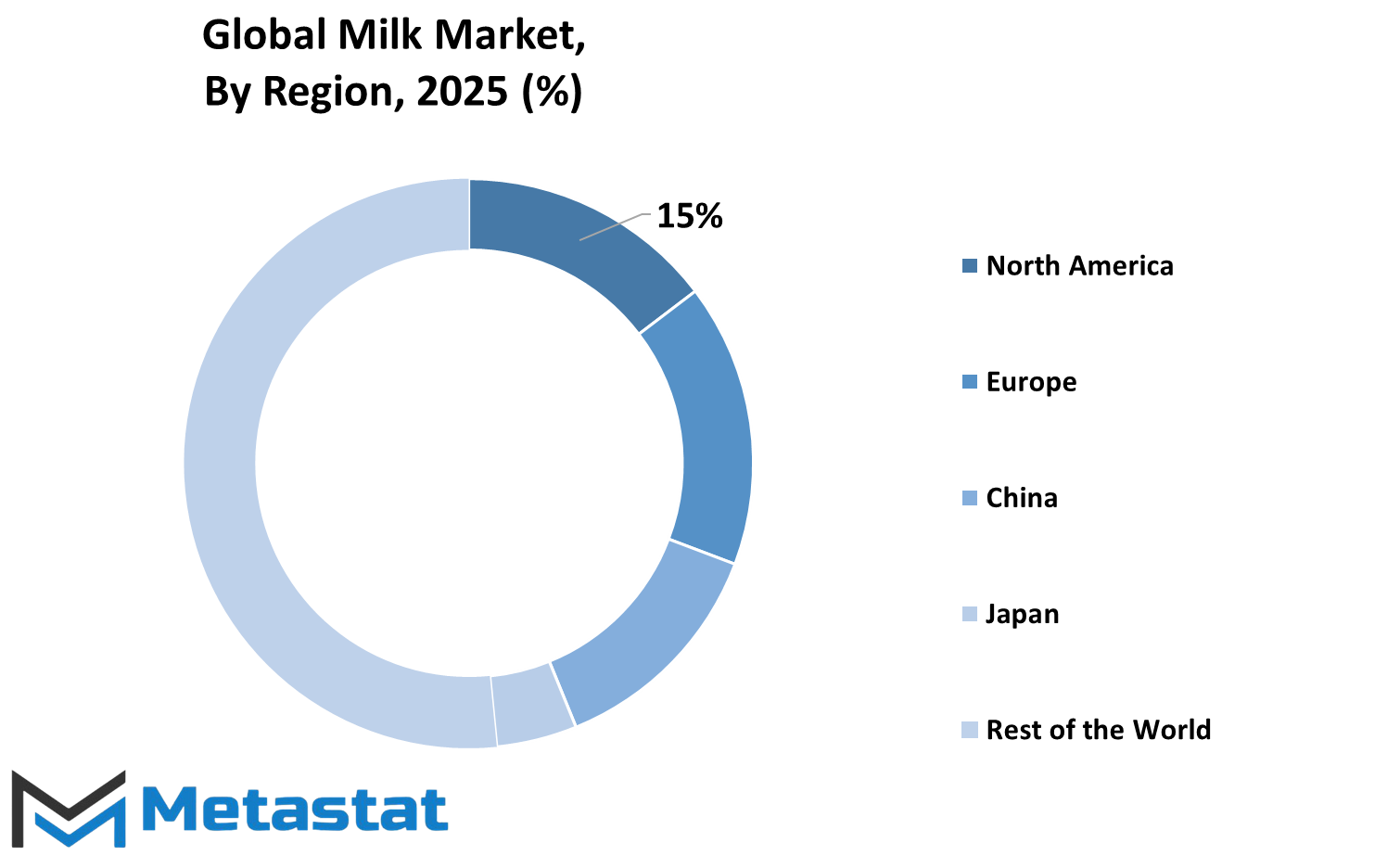
COMPETITIVE PLAYERS
In recent years, the marketplace for Global Milk is most likely to change as per the competitive players forming its future. Industry insiders have suggested that the biggest brands of today, such as Nestle, Danone, Lactalis, and Fonterra, will continue to play a part in shaping the market dynamics via their new strategies of either acquiring market share or making themselves completely competitive in the market. Since the frontrunners in the industry are these companies, there are possible chances that they are going to invest in technology and product development suiting the changing taste of the consumers and increasing demand for alternatives.
At a time when consumers are aware of the relevance in keeping healthy and being green, companies like Dairy Farmers of America and FrieslandCampina cannot skip resorting to organic and eco-friendly products. This would ensure catering to consumers' fast-growing demands and also being in sync with the global move toward sustainability. For example, FrieslandCampina may continue to explore pathways for low-carbon-footprint milk production, hence creating a benchmark within the sector.
The scenario thus creates the likelihood where Arla Foods and Saputo Inc. would fortify their chances within the market since they would have amalgamated strategies for merging and acquisition in order to broaden their product line-up and existing range, as well as cover root into newer geographical territories. Expansion strategies will be further significant with regards to meeting the wide-ranging needs of the global consumers, particularly in the emerging markets that would experience an onslaught in demand of milk and dairy products in the future.
The two powerhouses that are most likely to dominate the scene in Asia would be Yili Group and Mengniu Dairy because they project regional power with their extensive presence locally and deep knowledge of regional taste and preference. Furthermore, these companies are probably going to start expanding operations outside of domestic markets to tap the rising middle class in adjacent countries and also increase their global footprint.
It will also be very much a success in keeping business for Meiji Holdings Co. and Amul, the former with newly innovated dairy products and the latter with big brand loyalty among its customer base across India. How they remain competitive will depend on their ability to innovate without alienating many customers that they have built their clientele on for so long.
The Europeans, such as Parmalat and Sodiaal, would probably be much more preoccupied with premium products for the demanding European tastes that become high on the ethically produced dairy products. DMK Deutsches Milchkontor, another major player across Europe, would focus on efficiency and sustainability of operations-benchmarking the industry along such lines.
For instance, firms like Morinaga Milk Industry Co., Schreiber Foods, and Unilever will continue to have major stakes in the global market.
Milk Market Key Segments:
By Source
- Cow Milk
- Goat Milk
- Buffalo Milk
- Sheep Milk
- Camel Milk
- Plant Based Milk
By Form
- Whole Milk
- Reduced-Fat Milk
- Low-Fat Milk
- Skim Milk
By Distribution Channel
- Supermarkets and Hypermarkets
- Convenience Stores
- Online Retail
- Specialty Stores
- Direct Sales
By Application
- Household Consumption
- Food & Beverage Industry
- Dietary Supplements
- Cosmetics and Personal Care
- Animal Feed
- Others
Key Global Milk Industry Players
- Nestlé
- Danone
- Lactalis
- Fonterra
- Dairy Farmers of America
- FrieslandCampina
- Arla Foods
- Saputo Inc.
- Yili Group
- Mengniu Dairy
- Meiji Holdings Co.
- Amul (Gujarat Cooperative Milk Marketing Federation)
- Dean Foods
- Parmalat
- Sodiaal
WHAT REPORT PROVIDES
- Full in-depth analysis of the parent Industry
- Important changes in market and its dynamics
- Segmentation details of the market
- Former, on-going, and projected market analysis in terms of volume and value
- Assessment of niche industry developments
- Market share analysis
- Key strategies of major players
- Emerging segments and regional growth potential



.png)
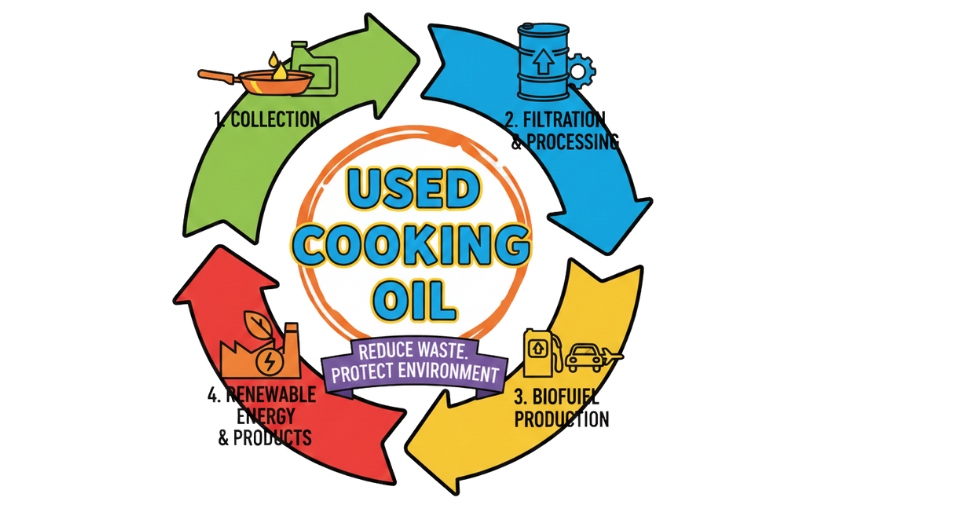
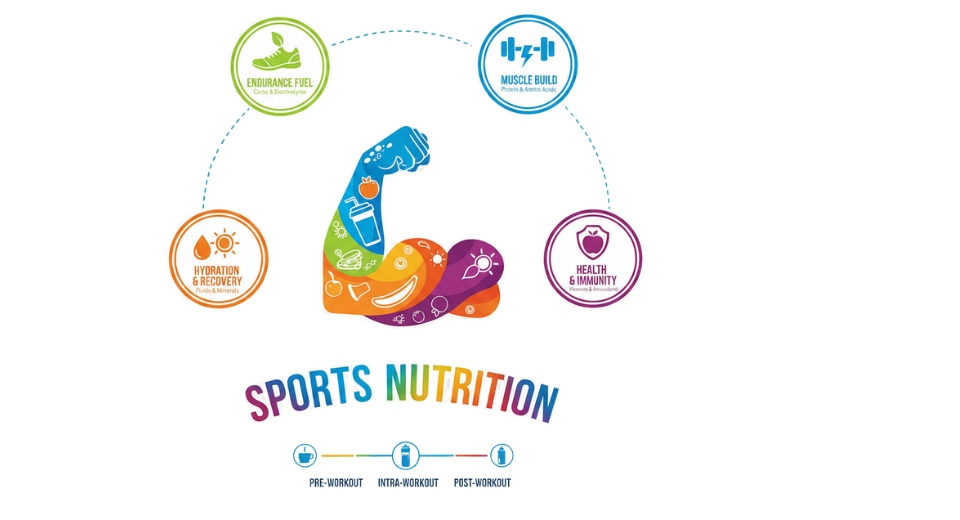
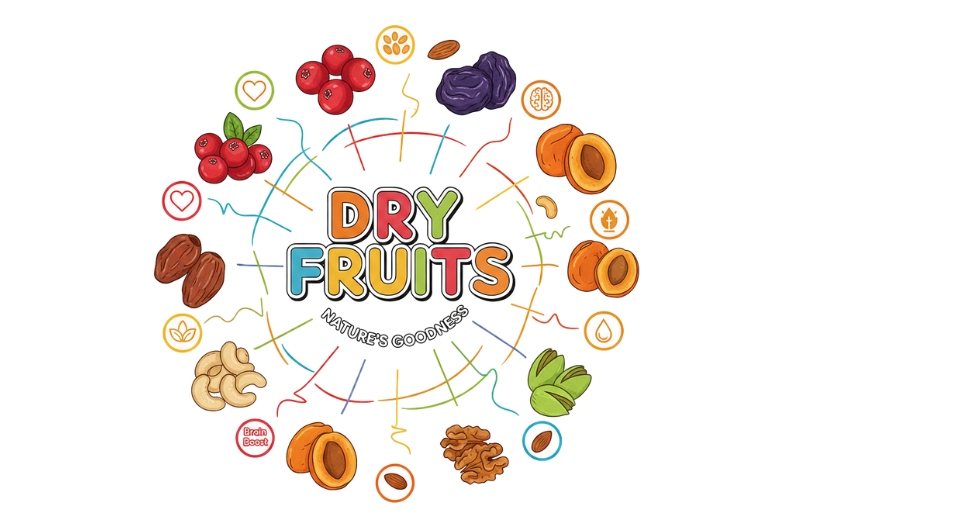

 US: +1 3023308252
US: +1 3023308252






